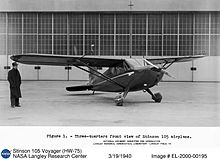Stinson Voyager
| Voyager | |
|---|---|

| |
| Model 105 in 2005 | |
| Role | Light utility monoplane |
| National origin | United States |
| Manufacturer | Stinson Aircraft Company |
| First flight | 1939 |
| Primary user | United States Army |
| Number built | 277 (Model 105) 775 (Model 10) |
| Variants | L-5 Sentinel Stinson Model 108 |
The Stinson Voyager was a 1940s American light utility monoplane built by the Stinson Aircraft Company.[1]
Development
First developed as the Stinson Model 105 in 1939, the Voyager was a high-wing three-seat braced monoplane powered by either a 75-hp (63.4-Kw) Continental A-75 or an 80-hp (67.7-Kw) Continental A-80-6.[1] This was developed into the Model 10 powered by a Continental A-80 piston engine.[1] The Model 10 introduced a wider cabin as well as an improved standard for the interior and finish.[1] The Model 10 was followed by the Model 10A, powered by a Franklin 4AC-199 engine and the Model 10B with a Lycoming GO-145.[1]
Six Model 10As were evaluated by the United States Army Air Forces (USAAF) as the YO-54. The successful tests led to an order for the slightly larger and heavier O-62, later designated the L-5 Sentinel.[1]
A number of Model 105s and Model 10As were impressed into USAAF service as the AT-19 (later L-9).[2]
After World War II, the type was developed as the Model 108, the prototypes being converted Model 10As.[2]
Variants

- Model 105
- Production variant also known as the HW-75 with a Continental A-75 engine), or HW-80 with a Continental A-80 engine, 277 built.[2]
- Model 10
- Improved production variant with an 80 hp Continental A-80 engine, 260 built.[2]
- Model 10A
- Variant with a 90 hp Franklin 4AC-199 engine, 515 built (10A and 10B).[2]
- Model 10B
- Variant with a 75 hp Lycoming GO-145 engine, 515 built (10A and 10B).[2]
- YO-54
- United States Army designation for six Model 10s for evaluation.[3]
- AT-19A
- Original military designation for eight Model 105s impressed in 1942, later changed to L-9A.[4]
- AT-19B
- Original designation for 12 impressed Model 10A Voyagers, later changed to L-9B.[4]
- L-9A
- Final designation for eight impressed Model 105 Voyagers, originally AT-19A.[4]
- L-9B
- Final designation for 12 impressed Model 10A Voyagers, originally AT-19B.[4]
Operators
- Brazilian Air Force - Model 105
Specifications (105)
Data from General Dynamics Aircraft and their Predecessors [5]
General characteristics
- Crew: one
- Capacity: two passengers
- Length: 22 ft 2 in (6.76 m)
- Wingspan: 34 ft 0 in (10.36 m)
- Height: 6 ft 6 in (1.98 m)
- Wing area: 155 sq ft (14.4 m2)
- Airfoil: NACA 4412
- Empty weight: 923 lb (419 kg)
- Gross weight: 1,580 lb (717 kg)
- Powerplant: 1 × Continental A-75-3 air-cooled flat-four, 75 hp (56 kW)
Performance
- Maximum speed: 105 mph (169 km/h, 91 kn)
- Cruise speed: 100 mph (160 km/h, 87 kn)
- Range: 350 mi (560 km, 300 nmi)
- Service ceiling: 10,500 ft (3,200 m)
- Rate of climb: 430 ft/min (2.2 m/s)
See also
Related development
Related lists
References
- Notes
- Bibliography
- Andrade, John. U.S.Military Aircraft Designations and Serials since 1909. Leicester, UK: Midland Counties Publications, 1979. ISBN 0-904597-22-9.
- The Illustrated Encyclopedia of Aircraft (Part Work 1982-1985). London: Orbis Publishing, 1985.
- Simpson, R.W. Airlife's General Aviation. Shrewsbory, Shrops, UK: Airlife Publishing, 1991. ISBN 1-85310-194-X.
- Wegg, John. General Dynamic Aircraft and their Predecessors. London: Putnam, 1990. ISBN 0-85177-833-X.
